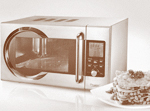 Different types of food heat up at different rates. Dense foods, as I have mentioned, will take longer to heat through than lighter-textured foods, and foods with a great deal of water, fat or sugar in them will heat up or cook though more quickly than foods without. (This is why, again, when reheating a mince pie, the filling gets very not before the pastry seems warm. Always test with a skewer.) Meat on the bone cooks quicker than meat off the bone. Thin ends cook more quickly than thicker ends.
Different types of food heat up at different rates. Dense foods, as I have mentioned, will take longer to heat through than lighter-textured foods, and foods with a great deal of water, fat or sugar in them will heat up or cook though more quickly than foods without. (This is why, again, when reheating a mince pie, the filling gets very not before the pastry seems warm. Always test with a skewer.) Meat on the bone cooks quicker than meat off the bone. Thin ends cook more quickly than thicker ends.
Microwaved Foods
ROASTING: As I have indicated, I prefer not to roast beef or pork in the microwave as I find the results are often tougher than I would like, and unattractive in appearance. However, pork crackling gets very crisp if cooked separately in the microwave. Lamb does better than either beef or pork, to my taste, but on the whole the family prefer it done in the conventional way.
BREAD AND CAKES: I find it difficult to get used to their generally pasty appearance - that is, unless they are iced or topped and wrapped in clear film straightaway. They really should be eaten on the day of baking as they do tend to stale quickly. Ginger or chocolate-flavoured cakes are much better, though, as they look good and the flavour is fine.
Larger quantities
More often than not, large quantities take just best, therefore, to stick to small quantities as long to cook in the microwave as they do which work well and use my microwave tor 'normally' in the conventional oven. I find it what it does best.
Crisping and browning foods
Your instruction booklet that comes with your microwave is your best guide. However, bear the following points in mind, as each will affect the total cooking time:
The shape and thickness of the dish: this will alter the cooking time of the food - thick, earthenware dishes will protect the food from the waves and add a few seconds to the cooking time, whereas thinner, microproof thermoplastic dishes will allow the waves to penetrate more easily and reach the food quicker. Square dishes are not so good as microwaves seem to concentrate their energy in the corners (you can shield these with small pieces of foil as long as the foil does not touch the sides of the cooker cavity). Where possible choose round or ring-shaped dishes for cooking, as these will give the most even results.
The temperature of the food before cooking: food taken straight from the refrigerator will naturally take longer to cook than food that is already at room temperature. All frozen foods, with the exception of vegetables should be defrosted thoroughly before cooking. (Some microwave cookers will do this automatically, then go on to calculate the cooking time for you.) It saves energy to think ahead and thaw most things out overnight, in a cupboard in the kitchen (safe from pets) but, of course, you can also thaw a little ahead in your microwave before cooking.
The amount of food: smaller amounts cook more quickly than larger ones. If you are cooking several individual portions at once, they should be of similar weight, size and shape.
Composition of food: different types of food heat up at different rates. Dense foods, as I have mentioned, will take longer to heat through than lighter-textured foods, and foods with a great deal of water, fat or sugar in them will heat up or cook though more quickly than foods without. (This is why, again, when reheating a mince pie, the filling gets very not before the pastry seems warm. Always test with a skewer.) Meat on the bone cooks quicker than meat off the bone. Thin ends cook more quickly than thicker ends.

